Owner-chef Yoshihiro Murata observes that ‘the ryotei is the art gallery of the Japanese aesthetic.’ Given his status as one of the world’s top Michelin-starred chefs with seven stars to his name, we couldn’t miss the rare chance to dine at his three-starred restaurant, Kikunoi Honten.
Did Kikunoi Honten measure up to its lofty reputation? Before I spill the tea on my candid assessment of this establishment, let me clarify a few things about myself. You see, my life orbits around three major loves: my husband, travelling, and, of course, food. I make food the focal point of my travels, so much so that I’ve lived in Japan and make it a point to return annually for extended stays. I may not hold any official title as a food critic, but my palate is seasoned by frequent visits to an array of restaurants each year, spanning from casual eateries to Michelin-starred venues.
That said, Kikunoi Honten was a milestone for me—it was my very first experience with a three-starred Michelin restaurant. The cost of a sample menu does lean toward the pricier end, which is understandable given its global acclaim. My husband and I hadn’t ventured out much due to the pandemic, and an anniversary celebration was long overdue. So, after some due diligence, we concluded that Kikunoi Honten was our best choice for an unforgettable evening.
I aim to be as straightforward and transparent as possible in this review. While I acknowledge that reviews are inherently subjective, I’ll lay out all the details about my experience—ranging from pricing and location to the menu, ambiance, service, and each individual dish. This way, you’ll have a comprehensive understanding to help guide your own dining decisions.
Table of Contents
- The reservation process for Kikunoi Honten
- The location and ambiance at Kikunoi Honten
- The menu at Kikunoi Honten
- The food at Kikunoi Honten
- Palate cleanser and welcome drink
- Assortment of appetizers
- Steamed of cod milt, truffle sauce, chives
- Sashimi of fugu (pufferfish)
- Sashimi of yellow tail
- Red tilefish
- Baby turnip, Muge taro, Kintoki carrot, Kujo onion
- Salad of roe-bearing crab, Japanese citrus
- Hotpot of duck breast
- Porridge of rice
- Dessert
- The service at Kikunoi Honten
- The price at Kikunoi Honten
- Personal Thoughts
The reservation process for Kikunoi Honten
Getting a seat at Kikunoi Honten takes some planning. You’ve got to book way ahead of time. Sure, you can call or email the restaurant, but to lock in your spot, you’ll need to go through a site called Tableall. That’s what I did, and I booked our table about 3 months in advance.
The good news? Tableall has people who speak English, and they act like a go-between with you and the restaurant to make sure you get a table when you want it. I wanted a specific type of room, and the first option didn’t work for me. Tableall went back and forth with the restaurant until we found a room that did. The communication is done via email, so you don’t need to speak to anyone on the phone.
Now, the not-so-great news: Tableall charges a fee, and it’s not cheap. We’re talking 8000 yen per seat. They don’t have an annual fee or anything, but adding 8000 yen per person to the bill is something to keep in mind.
The location and ambiance at Kikunoi Honten
Kikunoi Honten is located in Higashiayama Kyoto, which, let’s face it, it’s the most beautiful part of the city. It’s tucked in a little cul-de-sac just 5-minute walk from Maruyama Park. The restaurant itself is located in a traditional Japanese house with bamboo stalks at the entrance.
The street is beautifully illuminated at night and the restaurant can be reached by taxi or on foot if you prefer to walk. We arrived by taxi but left on foot to enjoy a late night walk and have the opportunity to walk around Higashiyama without anybody else around.
There are ten private rooms seating from two to fifty people within the restaurant and every reservation gets its own private room, which is feels rather special. Most rooms at this dining establishment are designed with traditional tatami mats, but several feature hori-kotatsu tables. One unique room was crafted to resemble a boat, a creative touch from the chef himself. Another secluded room on the second floor was a favourite of Prince Hirobumi Ito, a significant figure in the Meiji Restoration. There’s also one room that deviates from Japanese aesthetics, adorned with European antiques, French stained-glass, a century-old Persian rug, and even a chair dating back to the era of Napoleon III.
We had a tatami room with a hori-kotatsu table for added comfort, which we appreciated. A horigotatsu is a low table set over a recessed floor, where you sit on zaisu (tatami chairs) or cushions at the table but with their legs hanging down into the recessed area. This makes it much more comfortable for people like us, unaccustomed to sitting in the traditional seiza position for prolonged periods of time.
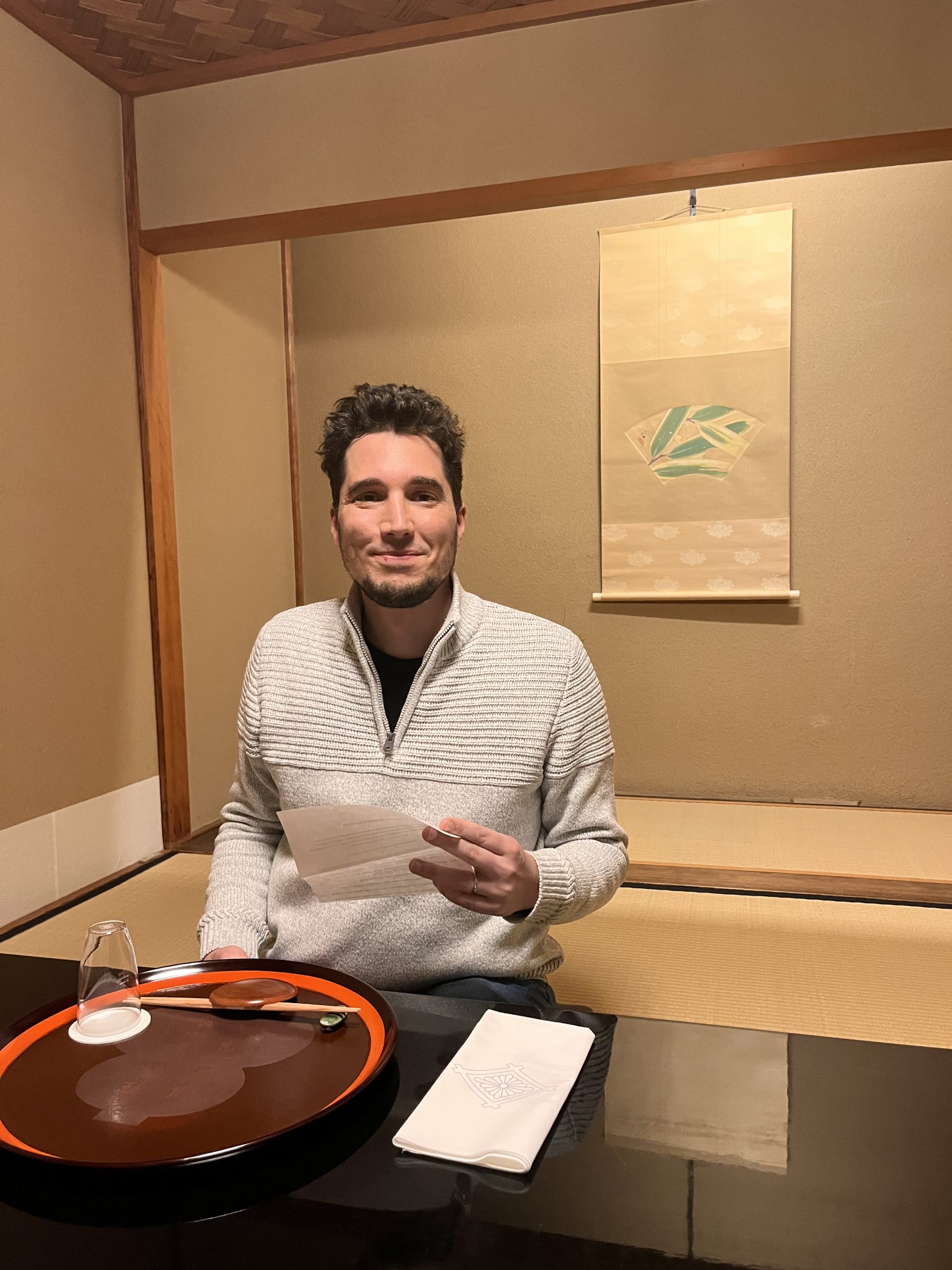
The menu at Kikunoi Honten
The menu at Kikunoi Honten is ever-changing, adapting to the seasons with a focus on fresh ingredients. Our visit came at the start of December, allowing us to experience their winter-centric offerings.
As for the presentation, the menu was printed on thick unryu paper, a type of paper made from Mulberry tree bark fibers, lending it a textured, artistic quality. The restaurant’s own hanko (stamp) at the bottom added a personalized touch.
The evening featured a 10-course menu, which was designed to highlight the best of seasonal Japanese ingredients. Here’s a rundown of the courses for those interested:
- Assortment of appetizers: smoked salmon sushi, mustard-dressed rapini, haddock roe terrine, lotus root stuffed with mustard, cured karasumi (grey mullet roe) rolled in cuttlefish, tofu pickled in white miso and pomegranate, salad of sea cucumber and turnip
- Steamed of cod milt, truffle sauce, chives
- Sashimi of fugu (pufferfish), fugu skin, grated radish with red pepper, chives, vinegared chrysanthemum petals, salt and Naoshichi Japanese citrus), ponzu
- Sashimi of yellow tail, grated mustard radish, soy sauce
- Red tilefish steamed with grated kabura turnip, wood ear mushroom, lily bulb, mitsuba herb, fresh uni (sea urchin), gingko nut, wasabi
- Baby turnip, Muge taro, Kintoki carrot, Kujo onion and gluten roasted in a yuzu peel with yuzu miso
- Salad of roe-bearing crab, Japanese citrus
- Hotpot of duck breast, green onion, duck meatballs, sansho pepper
- Porridge of rice, cod milt, bone-in pufferfish meat, rice cake, yuzu, and seri herb;
- Buckwheat walnut sponge cake, caramel ice cream, strawberry, Amakusa orange, caramel sauce, mint
I’ve had kaiseki meals before, and generally, the more unconventional items turn out to be surprisingly delightful. Given this, and the restaurant’s reputation, I entered with the expectation that each bite would be extraordinary.
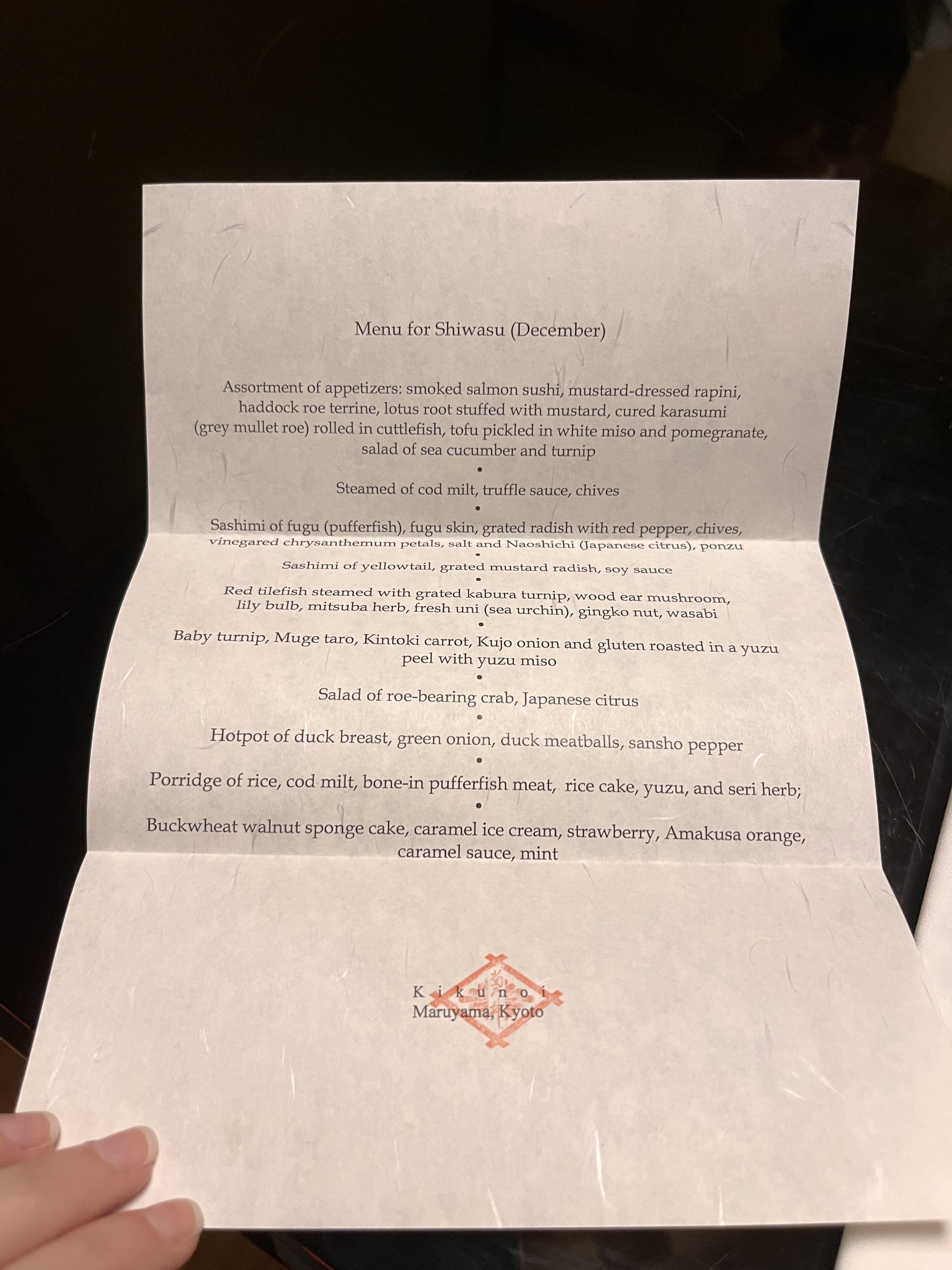
The food at Kikunoi Honten
Here is my honest opinion about every single course we sampled at Kikunoi Honten.
Palate cleanser and welcome drink
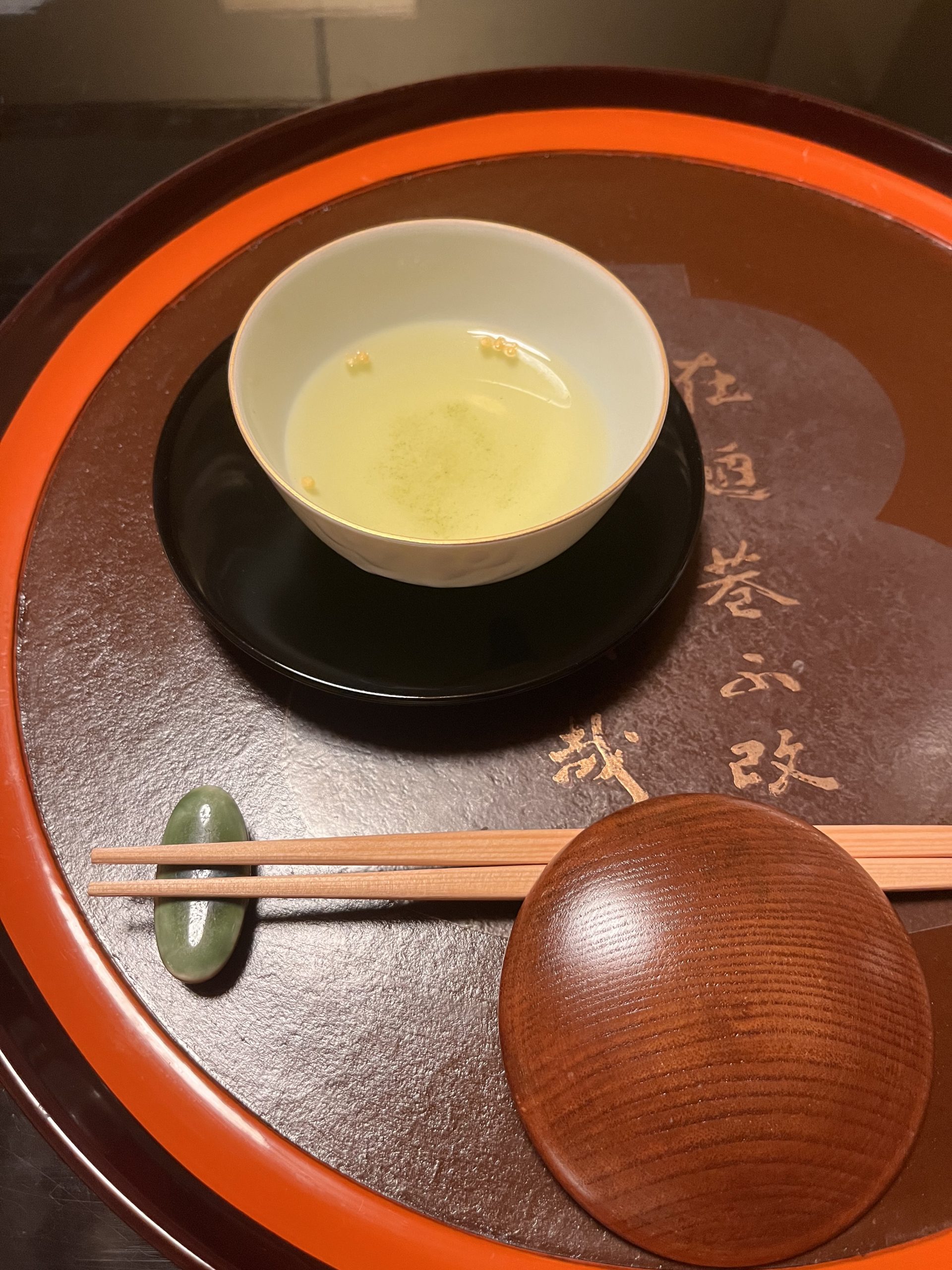
Upon being seated, we were served a cup of hot tea, a welcoming gesture customary in Japanese culture. Typically, this would be a type of green tea, intended to make guests feel at home.
The tea arrived on a wooden tray, accompanied by our evening’s menu and chopsticks, which were set on a small rest known as a hashioki.
Taste – As someone who thoroughly enjoys tea, particularly green varieties, I found the flavour to be excellent, and the tea served its purpose as a palate cleanser well.
Presentation – The cup was simple but functional. While nothing extraordinary, it was easy to hold and fit the occasion.
Tableware – One aspect that did catch my attention was the use of disposable chopsticks. For an establishment of this caliber, I anticipated chopsticks of a more distinguished variety, perhaps artisan-crafted from special lacquered wood.
Assortment of appetizers
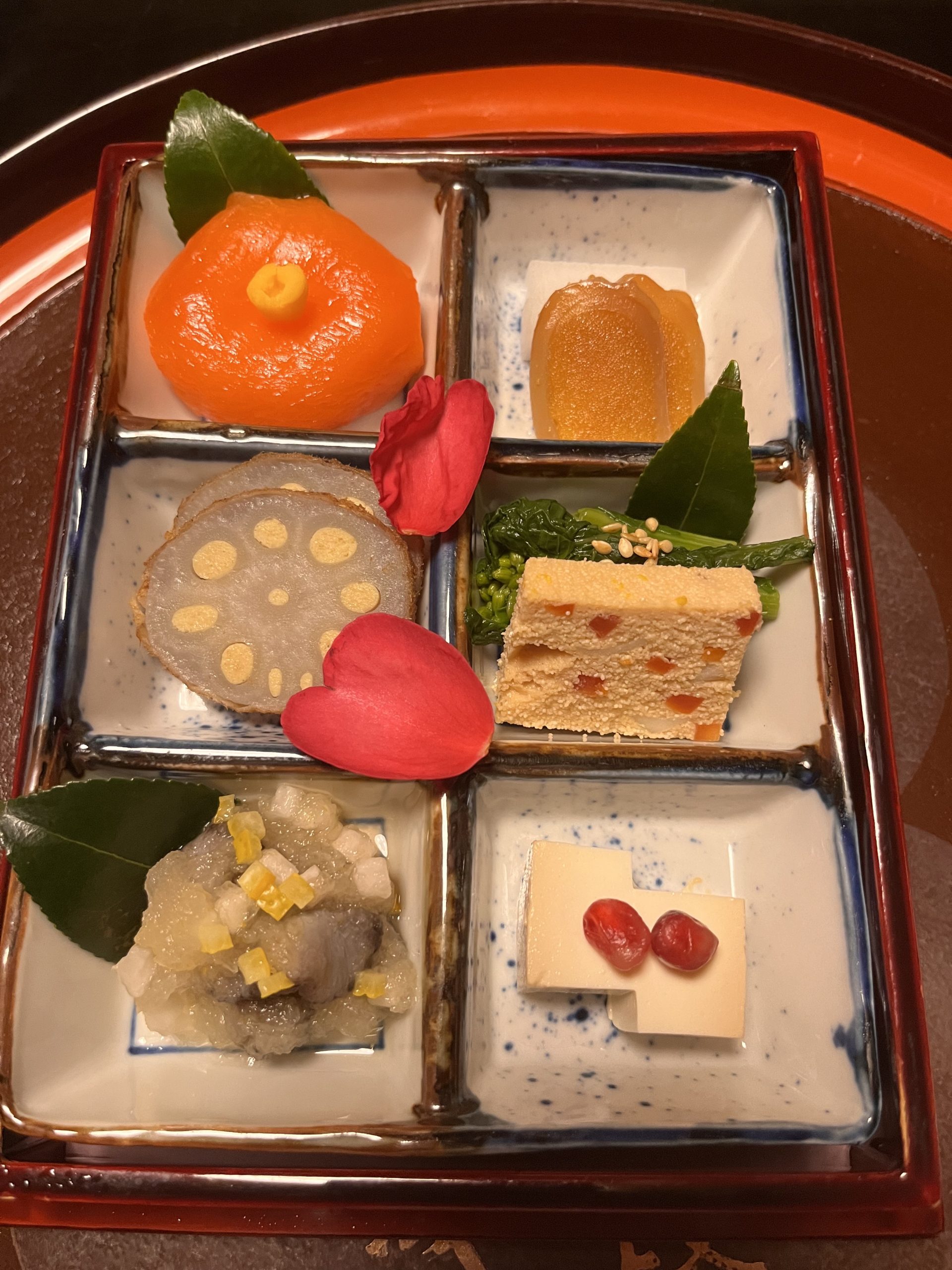
Next, we were presented with a selection of six appetizers: smoked salmon sushi, mustard-dressed rapini, haddock roe terrine, lotus root stuffed with mustard, cured karasumi (grey mullet roe) rolled in cuttlefish, tofu pickled in white miso and pomegranate, and a salad of sea cucumber and turnip.
These items certainly sounded enticing on paper, and my expectations were high, especially given my fondness for smoked salmon, haddock roe, and tofu dishes in fine dining settings. However, the overall experience fell short of those expectations.
Taste – It’s not easy to say this about a restaurant of such repute, but the appetizers were largely forgettable. While not terrible, they didn’t live up to the standards one might anticipate from a Michelin three-star establishment. The textures seemed mismatched, and no single flavour captured my attention.
Presentation – Considering this is a fine dining environment, I was looking for culinary artistry on my plate. What arrived, however, appeared somewhat hastily assembled. Elements like yuzu leaves and rose petals were there, although they felt out of space, but the food itself seemed somewhat less than impeccably finished. For example, the tofu wasn’t precisely cut, and the haddock roe terrine appeared slightly irregular, undermining the visual appeal.
Tableware – The appetizers were served on a divided ceramic plate, itself placed within a lacquered box. While not unattractive, the tableware lacked the extra touch of elegance I was expecting. Closer examination of the ceramics revealed uneven colouring and inconsistencies that detracted from what should have been an artisanal look.
Steamed of cod milt, truffle sauce, chives
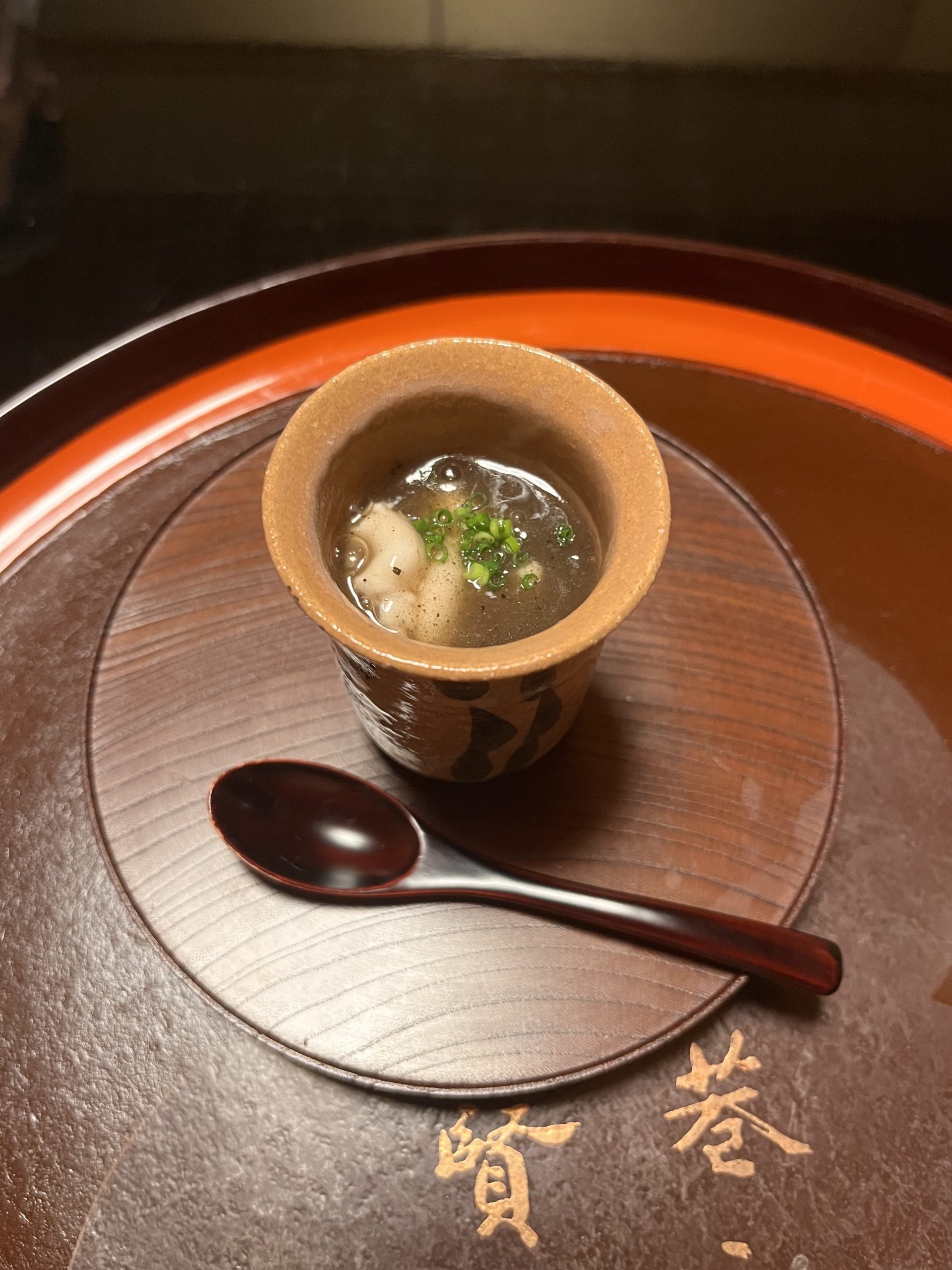
For those who are unfamiliar with milt, it’s essentially the seminal fluid of certain aquatic animals, rich in spermatozoa, and released during their breeding season. In the context of Japanese cuisine, it’s called “shirako,” which translates to “white children.” It’s considered a delicacy and can be found in various preparations like tempura, sautéed dishes, and soups.
Taste – The dish had a creamy texture, not dissimilar to custard, with a delicate and nuanced flavor profile. While the truffle sauce had a slightly slimy consistency, the overall taste was satisfactory.
Presentation – While I understand that I’m scrutinizing details here, it’s a Michelin three-star restaurant, and the expectations are high. The sauce could have been more refined; the presence of bubbles made it appear somewhat unfinished. Additionally, I noted that the chives lacked uniformity in both colour and cut, small details that matter in such a setting.
Tableware – Once more, the tableware selection didn’t particularly impress me. The dish was served in a lidded yunomi, a type of Japanese teacup. While I’m sure the choice of tableware carries its own story or significance, the style and colour did not elevate the dish or complement its aesthetics. I have a deep appreciation for Japanese ceramics; however, this particular choice failed to captivate me.
Sashimi of fugu (pufferfish)
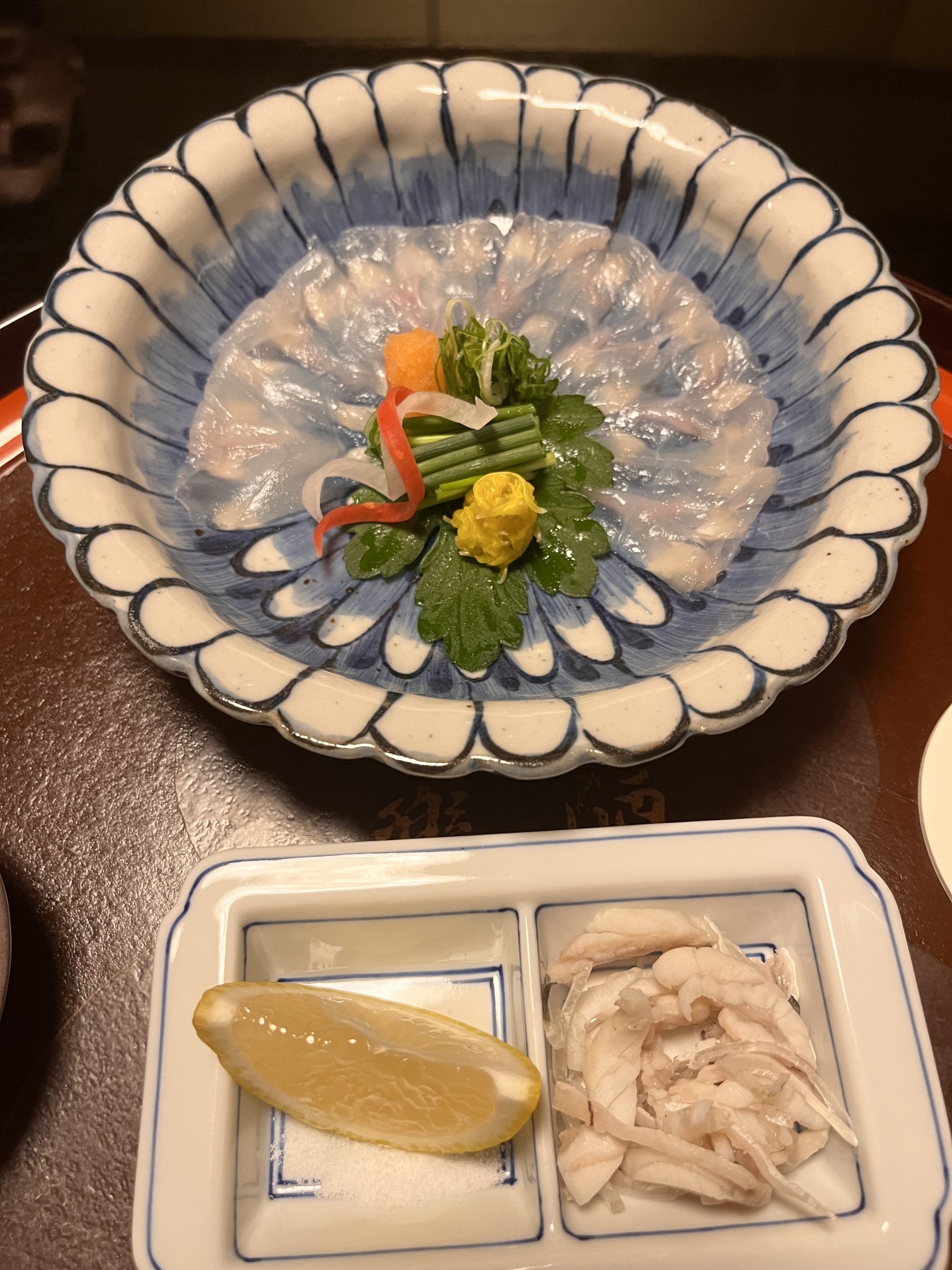
The course featured sashimi of fugu (pufferfish), accompanied by fugu skin, grated radish with red pepper, chives, vinegared chrysanthemum petals, salt, and Naoshichi—a rare Japanese citrus from Kochi prefecture—with ponzu sauce. For those unfamiliar, ponzu is a citrus-based sauce, somewhat akin to vinaigrette in Western cuisine.
Taste – The fugu itself offered a delicate, subtle flavour that didn’t overpower the palate. Unlike other types of sashimi that can be intensely fishy, fugu was restrained. The unusual texture of fugu skin and the well-balanced ponzu sauce elevated the dish, making for an overall pleasant culinary experience.
Presentation – While fugu preparation is an art that demands skill and precision, the presentation here fell short of those expectations. One could easily find images of fugu sashimi plated with meticulous care, which was unfortunately lacking in this case. For example, the inconsistent lengths of the chives and the casual placement of citrus and salt next to the fugu skin deviated from what one might expect in a fine dining setting.
Tableware – On the subject of tableware, there were no major grievances this time. The plate used for the fugu was well-designed, although the divided serving plate for the citrus and fugu skin left me uninspired. The ponzu serving bowl, while visually appealing, did not enhance the colour of the sauce it contained.
Sashimi of yellow tail
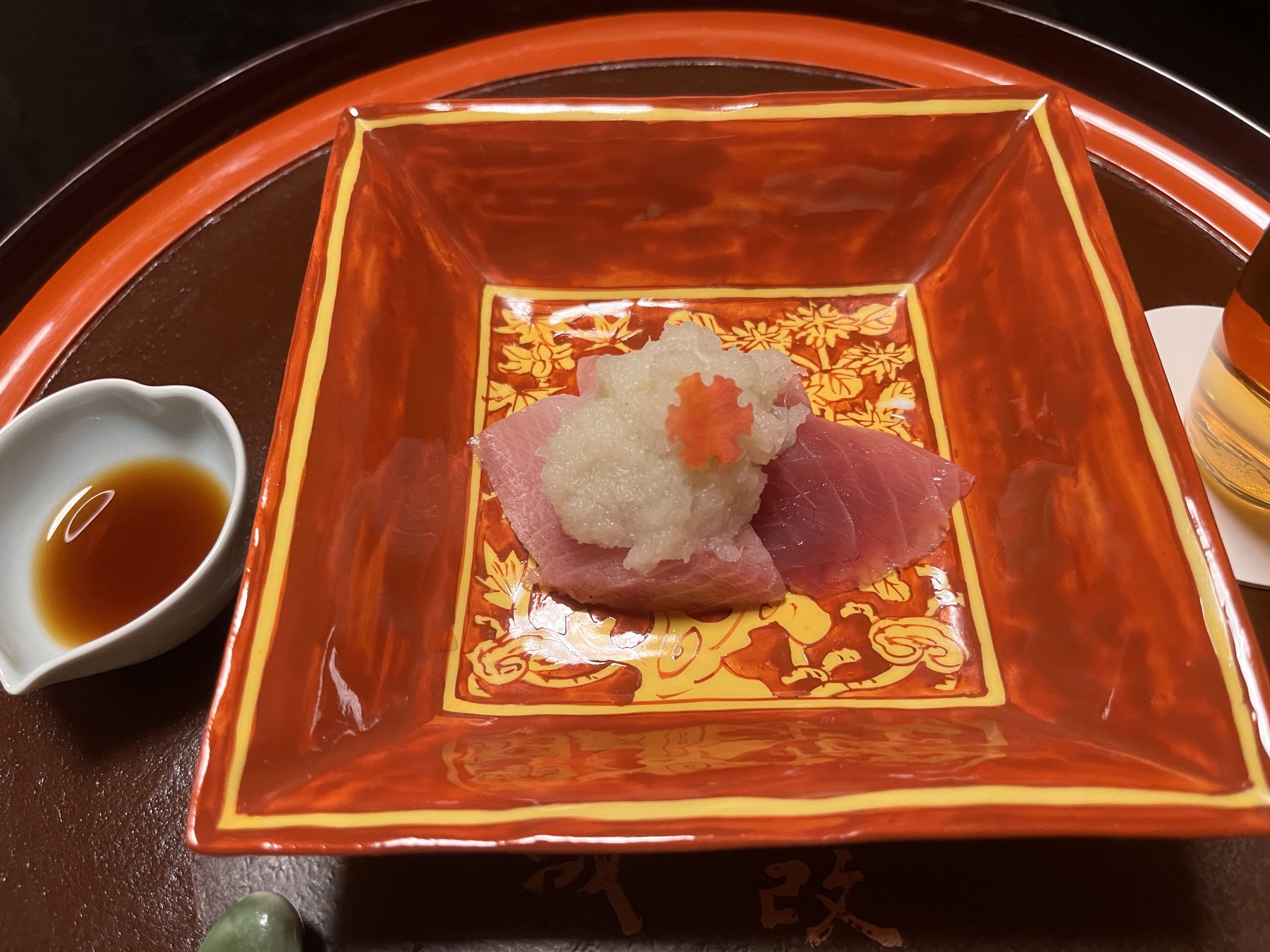
The course featured sashimi of yellowtail, accompanied by grated mustard radish and soy sauce.
Taste – While yellowtail sashimi is a common offering in many Japanese restaurants, this rendition was disappointingly pedestrian. The dominant mustard radish overshadowed the subtle flavour of the fish, resulting in a rather unbalanced experience.
Presentation – The dish lacked visual appeal, a critical aspect for sashimi which should be as much a feast for the eyes as it is for the palate. Instead of enhancing the fish, the mustard radish was haphazardly placed on top, diverting attention from the yellowtail. The additional carrot garnish felt out of place and failed to add any aesthetic or culinary value. The presentation missed the mark on the finesse and artistry one would expect in a fine dining environment.
Tableware – The ceramic plate, although possibly attractive in another context, failed to complement the dish. A more neutral or contrasting colour would have been preferable to accentuate the yellowtail. In this case, the tableware did little to enhance the overall dining experience.
Red tilefish
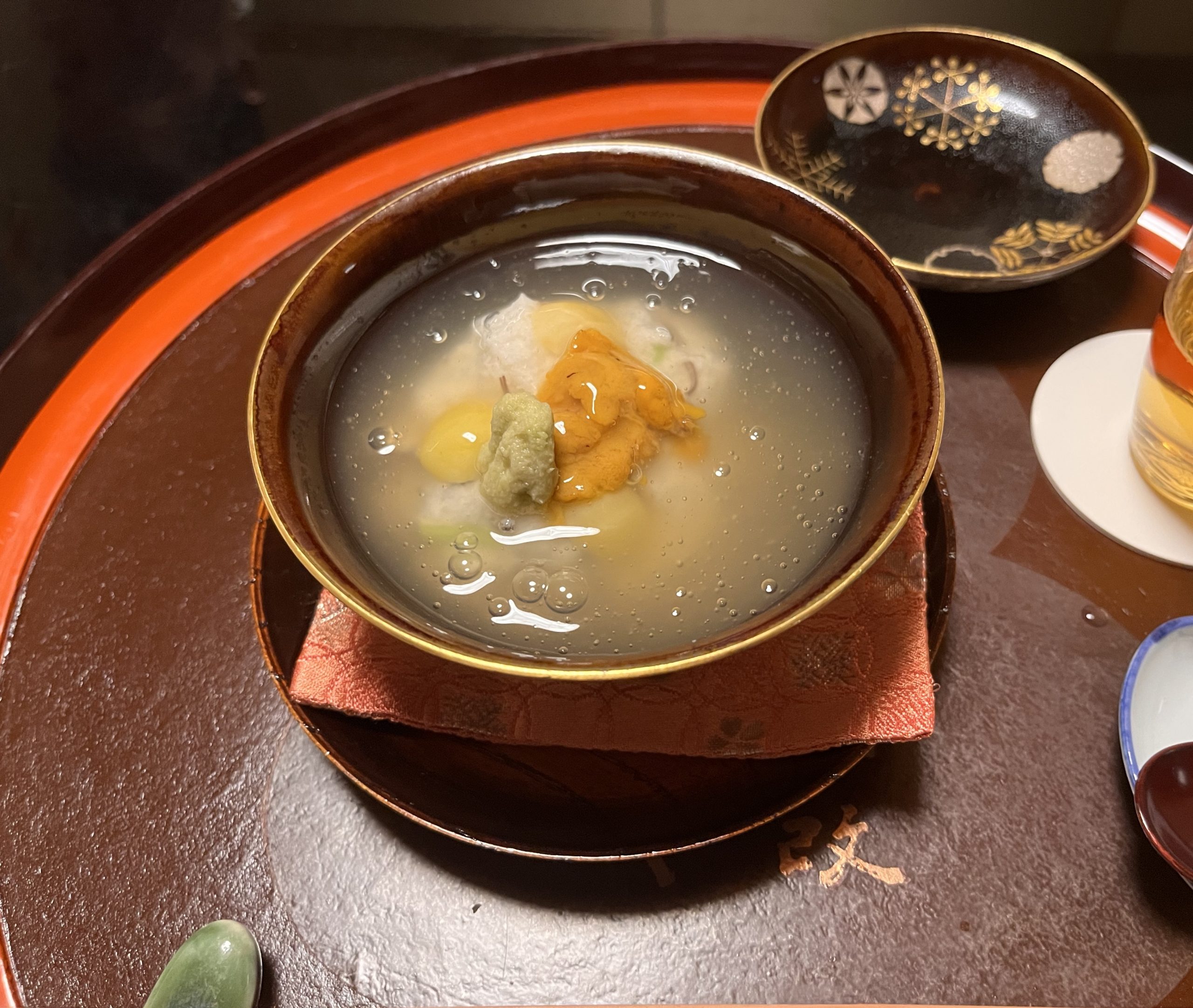
The course featured red tilefish steamed with an assortment of ingredients including grated kabura turnip, wood ear mushroom, lily bulb, mitsuba herb, fresh uni (sea urchin), ginkgo nut, and wasabi.
Taste – As a fan of uni, I had high hopes for this dish. While the individual ingredients like the tilefish and uni were satisfactory, their combination didn’t quite come together. The steamed preparation made the fish too soft, contributing to an overall gooey texture when combined with the thick liquid.
Presentation – I must confess that the dish failed to impress visually. Instead of highlighting each ingredient, the presentation resembled a haphazard assembly, undermining the culinary artistry one would expect from a fine dining experience. The lack of attention to the arrangement of ingredients like the uni and kabura turnip was particularly disappointing.
Tableware – The tableware was neither noteworthy nor offensive. It did little to elevate the dish, blending into the overall experience as unremarkable.
Baby turnip, Muge taro, Kintoki carrot, Kujo onion
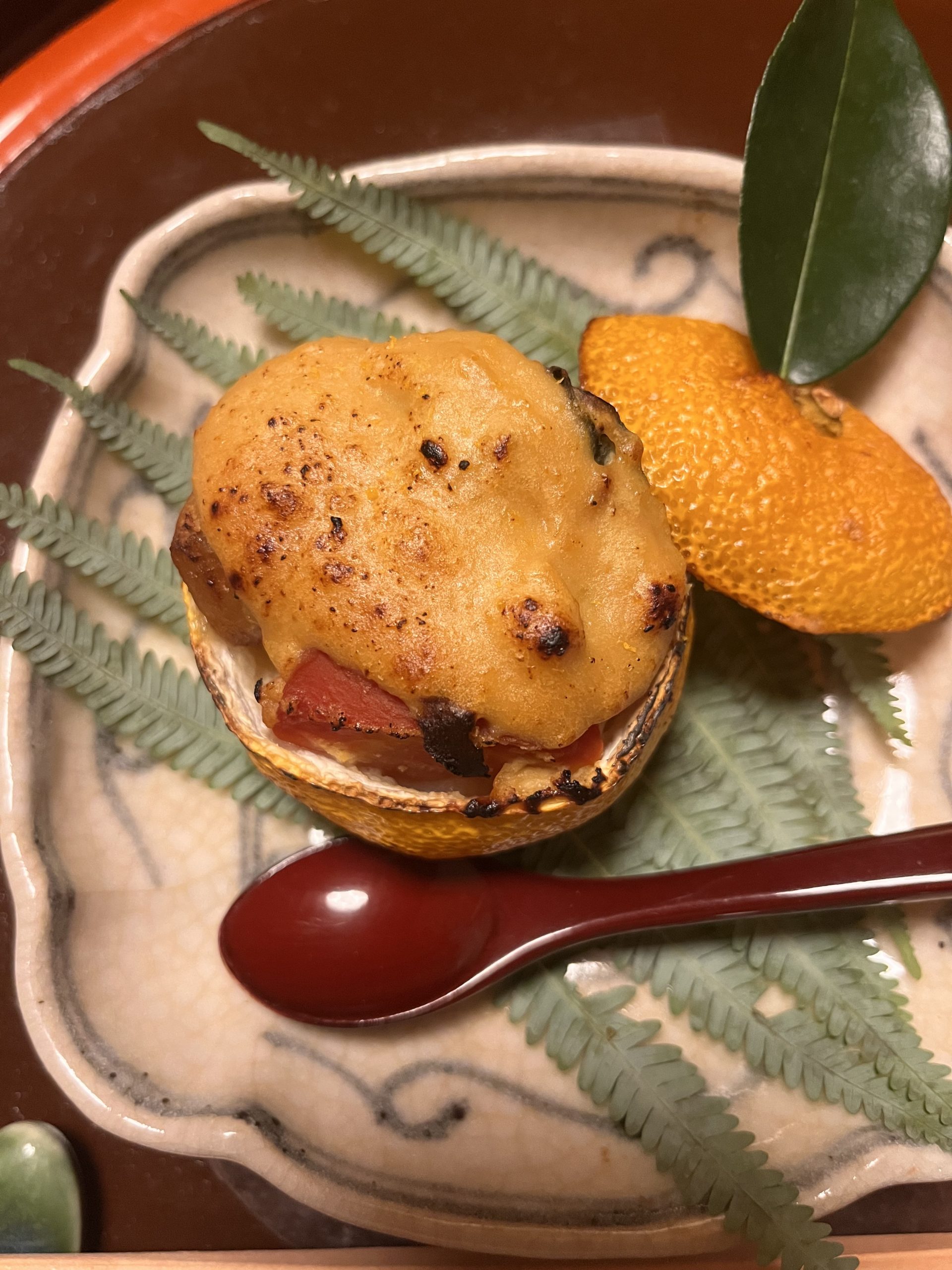
The full dish description is: Baby turnip, Muge taro, Kintoki carrot, Kujo onion and gluten roasted in a yuzu peel with yuzu miso.
Taste – The experience was overwhelmingly bitter, to the point where other flavours were completely overshadowed. The overcooked yuzu appeared to be the culprit, turning what could have been a harmonious blend of flavours into a monochromatic and unenjoyable taste profile. The mushiness of the ingredients further detracted from the experience.
Presentation – A dish served in a yuzu peel offers such potential for visual appeal, making it all the more disappointing when it fails to deliver. Here, both the yuzu miso and the citrus peel were burnt, causing not just a bitter taste but also a less-than-pleasing visual impact. The lack of attention to detail in cooking and presentation was glaringly evident.
Tableware – Given the colourful and vibrant nature of yuzu, the tableware did nothing to enhance or contrast with the dish. It was a missed opportunity to add an additional layer of aesthetic or thematic resonance to the meal. Instead, the plain tableware only served to further emphasize the dish’s shortcomings.
Salad of roe-bearing crab, Japanese citrus
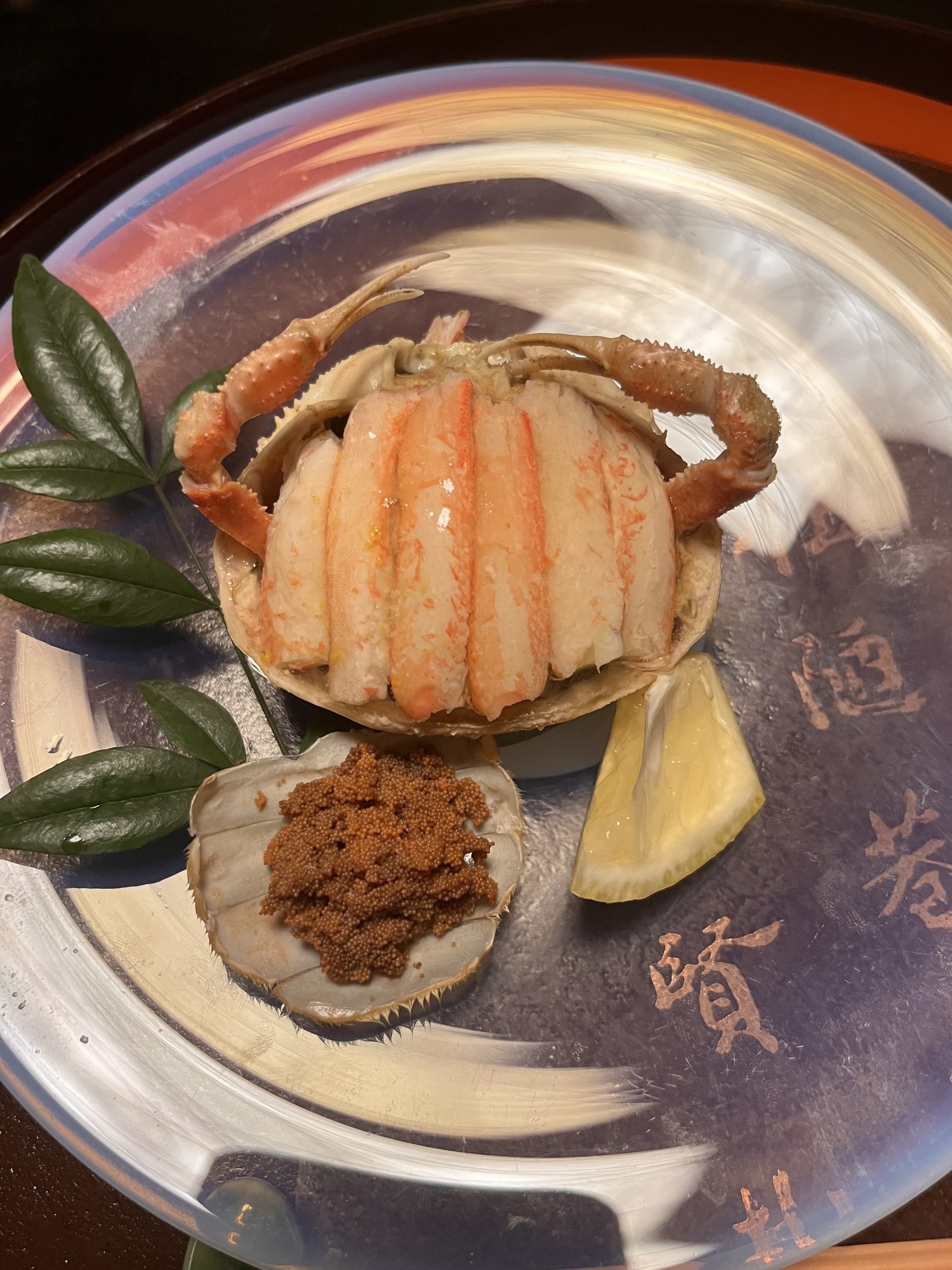
The crab dish was perhaps the most exceptional tasting of the evening, although there were areas where it could have shined brighter.
Taste – The crab was simply divine, even for someone who isn’t generally a crab lover. The roe was especially noteworthy, offering an exceptional flavor profile.
Presentation – While the crab meat was thoughtfully presented in its own shell, the roe felt like an afterthought. It appeared to have been dropped in rather hastily with a spoon. The presentation would have been elevated by arranging the roe into a quenelle and perhaps adding a delicate garnish on top.
Tableware – The use of a transparent plate was a missed opportunity. A more thematic or textured ceramic would have better complemented the dish, rather than a transparent surface that seemed to draw the eye to the tray underneath.
Hotpot of duck breast
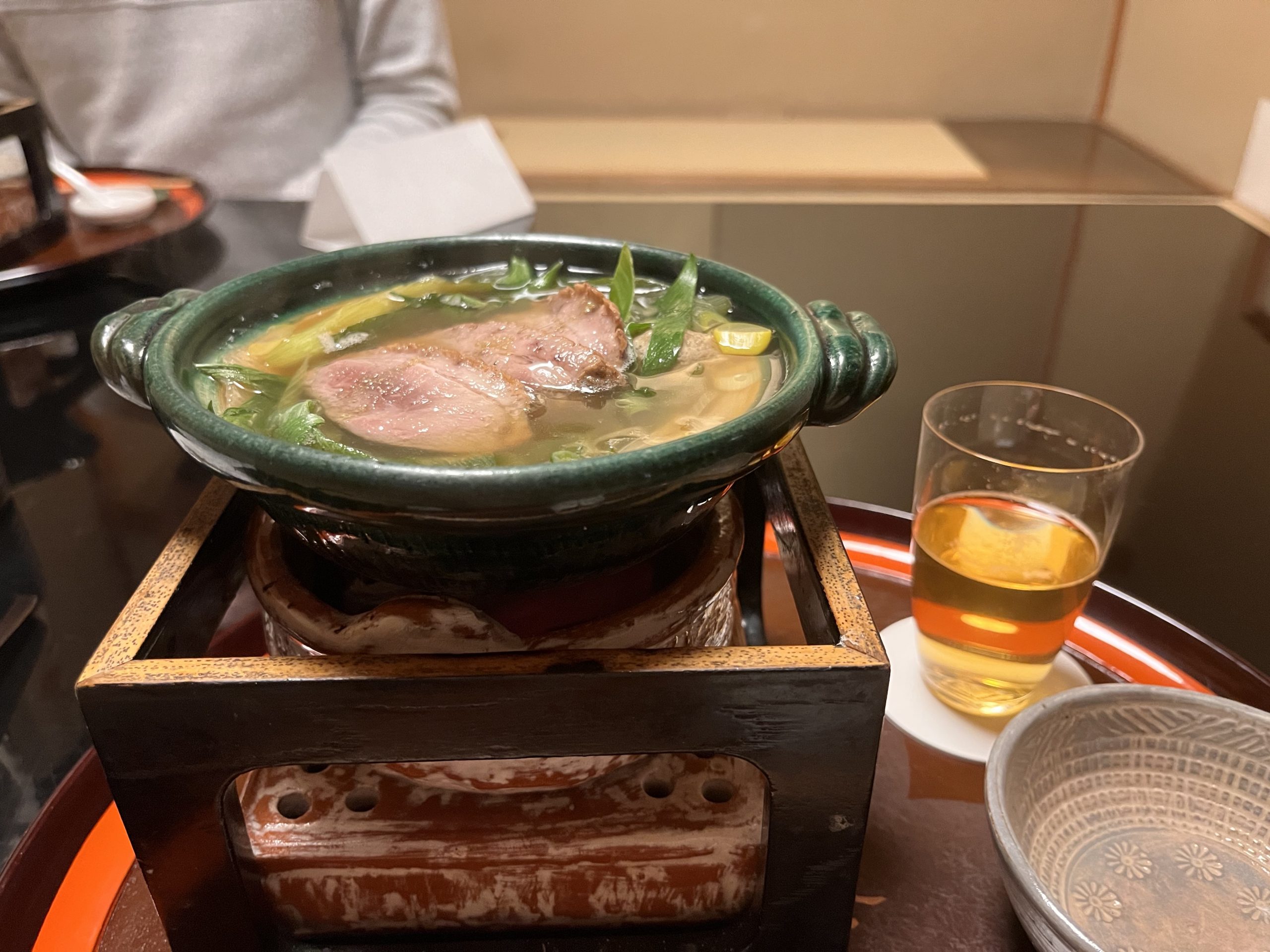
The course featured a hotpot of duck breast accompanied by green onion, duck meatballs, and sansho pepper. Duck often serves as the centrepiece of robust, flavourful dishes, and my anticipation was heightened by the dish’s promising description.
Taste – The broth offered a well-balanced flavour profile, contributing to the dish’s potential. However, the texture of the duck breast left room for improvement; it exhibited a noticeable chewiness that detracted from the overall experience. The duck’s fat was not adequately rendered, which could explain the textural issue.
Presentation – Aesthetically, the hotpot was commendable. The duck and greens were artfully arranged, providing a visual appeal that promised a flavourful experience.
Tableware – The serving vessel gave a nod to traditional hotpot containers, and while visually pleasing, it wasn’t necessarily what one might expect in a fine dining establishment.
Porridge of rice
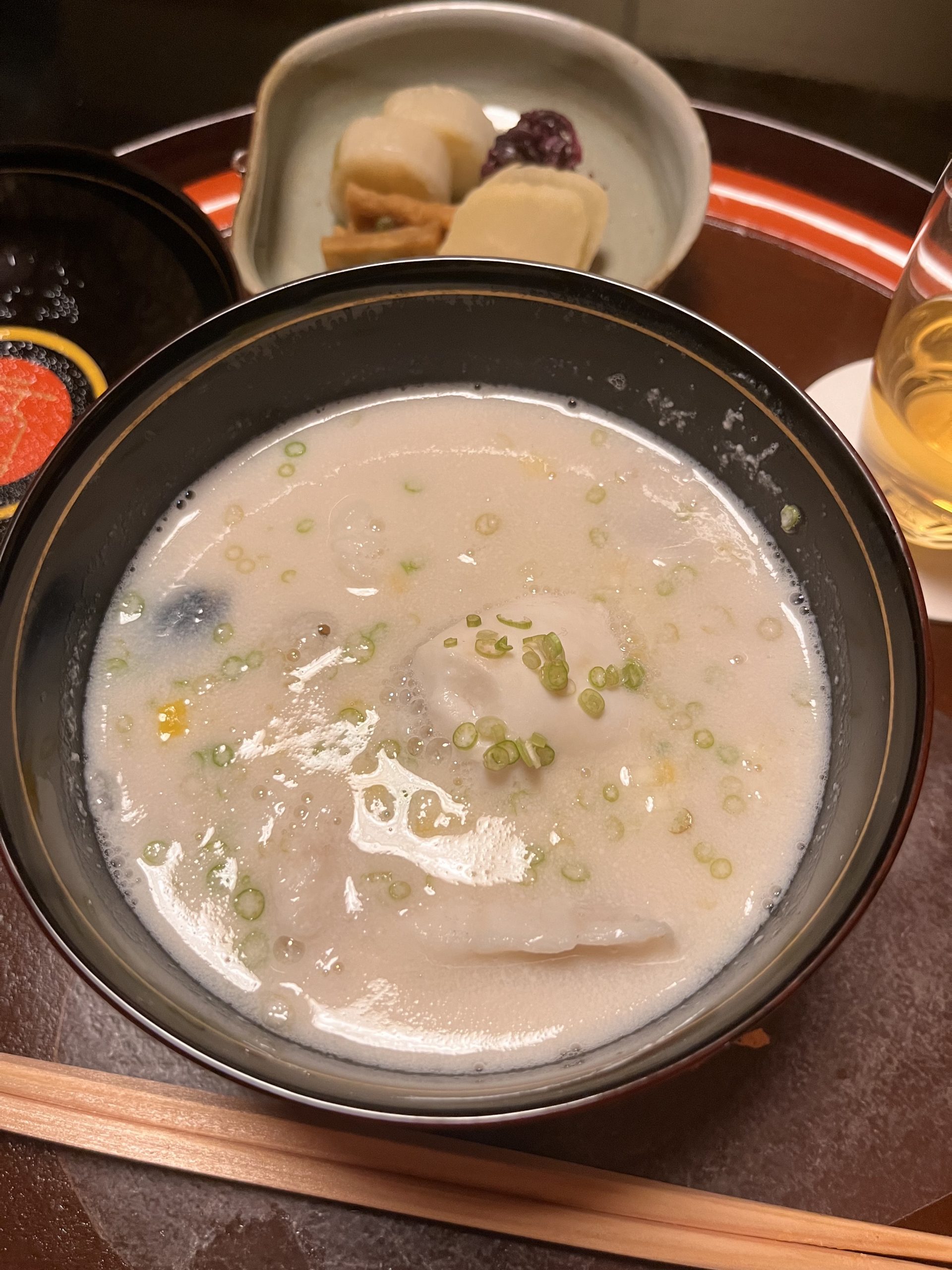
The course offered a porridge featuring rice, cod milt, bone-in pufferfish meat, rice cake, yuzu, and seri herb. At this point in the meal, a transition to a more texturally diverse dish would have been welcome. However, the porridge continued the trend of gelatinous and liquid-heavy offerings.
Taste – The porridge’s multitude of ingredients seemed to work against it, rather than for it. The complexity of individual components was lost, resulting in a dish that lacked a distinct flavour profile.
Presentation – Visually, the dish was rather nondescript. Comprising a somewhat monochromatic palette, it was served in a bowl with minimal ornamentation, adding little in terms of visual appeal.
Tableware – The chosen serving bowl seemed at odds with the fine-dining ambiance. Its thin, unremarkable design could be easily mistaken for something one might find at a budget-friendly store.
Dessert
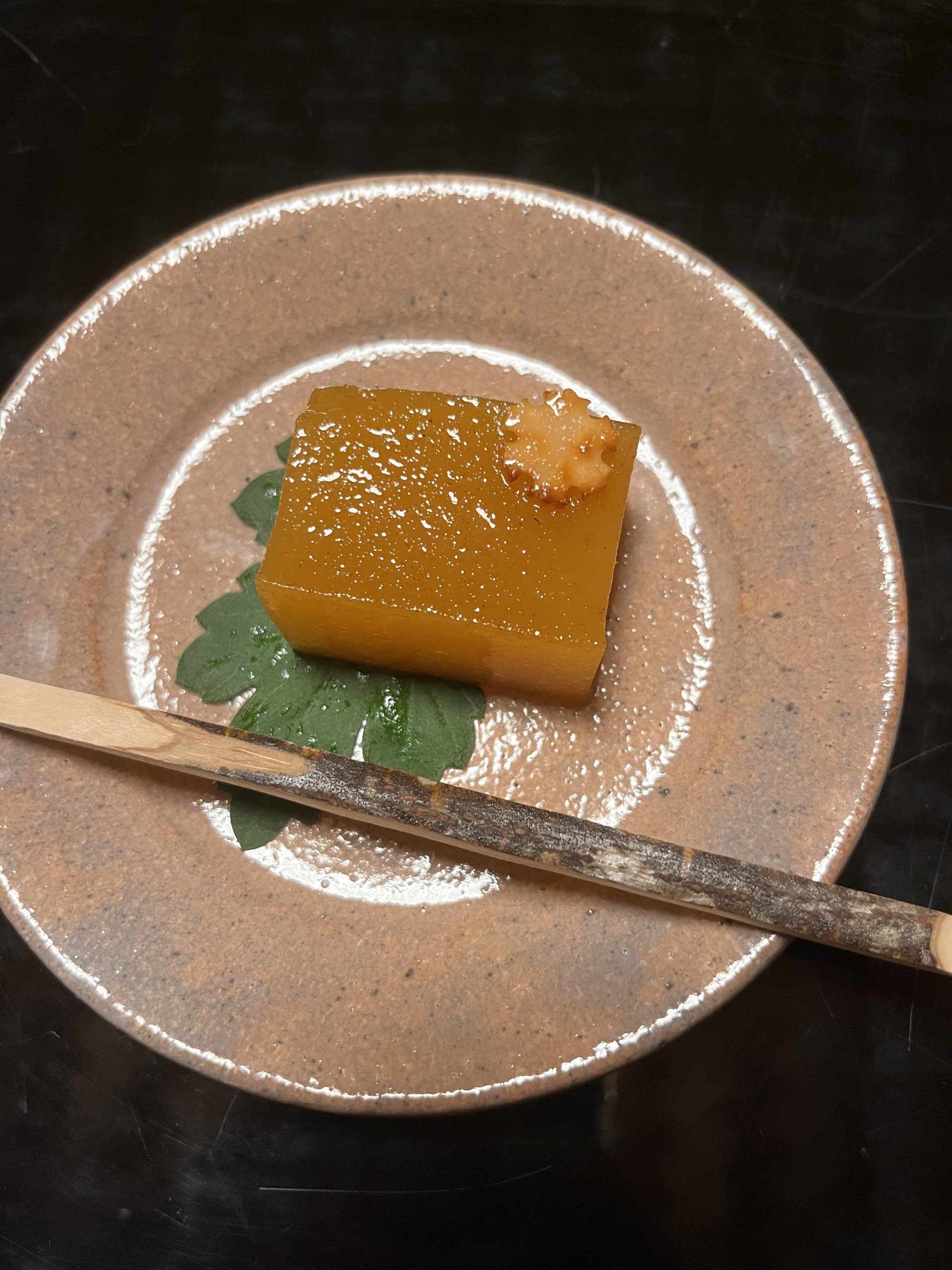
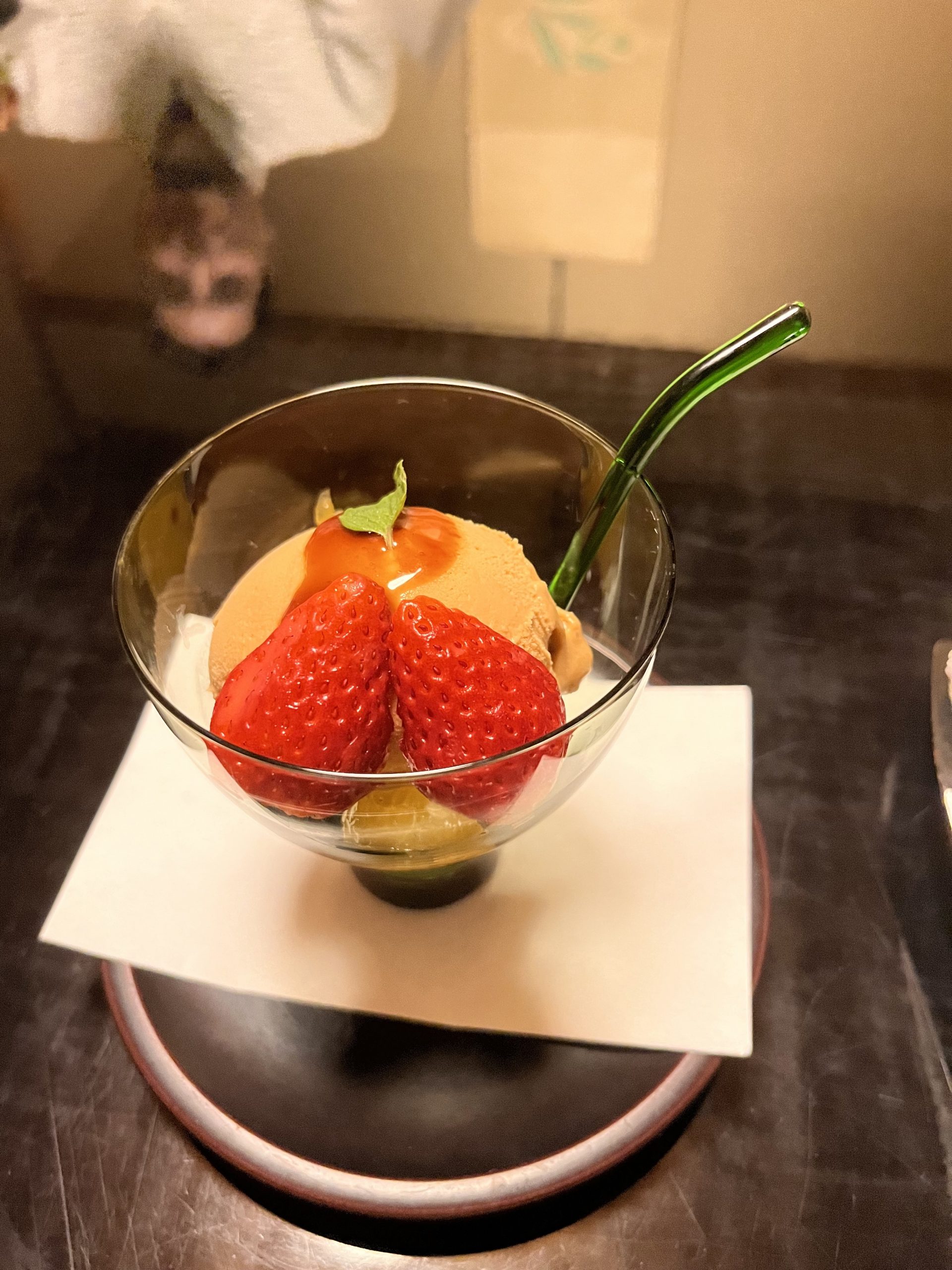
The final course featured a buckwheat walnut sponge cake, accompanied by caramel ice cream, strawberries, Amakusa orange, caramel sauce, and mint. While the sponge cake emerged as the highlight, the remaining components presented a mixed bag.
Taste – The sponge cake was well-executed, offering a gelatinous consistency that fit well with the overall theme of the meal. However, the caramel ice cream fell into the category of being merely adequate, lacking the depth of flavour one might expect in a fine-dining context. The strawberries were similarly unremarkable. I had high hopes that I would try the sweetest, more exquisite strawberries in Japan.
Presentation – The buckwheat walnut sponge was presented in a pleasing manner, though it stopped short of being visually striking. Conversely, the ice cream’s presentation was rather lacklustre, not meeting the standards typically set by fine-dining establishments.
Tableware – The choice of tableware once again raised questions. The transparent bowl used for serving did not enhance the dish’s visual appeal, and the teacups felt more suited for a homely setting than a Michelin-starred restaurant.
The service at Kikunoi Honten
The service at the restaurant was orchestrated by staff donned in traditional silk kimonos, known as nakai. Although the attire added an authentic touch to the ambiance, the overall experience with the service left a bit to be desired.
Service Quality: The servers neither came across as particularly warm nor detached. The service was efficient but felt somewhat hurried. We were escorted to our private dining room with haste, which curtailed our ability to fully appreciate the artwork adorning the restaurant—a noteworthy aspect given Chef Murata’s reputed collection.
Language Barrier: Given that we are English speakers dining in Japan, it’s possible that a language barrier may have contributed to a less personable experience. Overall, the service was functionally efficient but lacked a personalized touch.
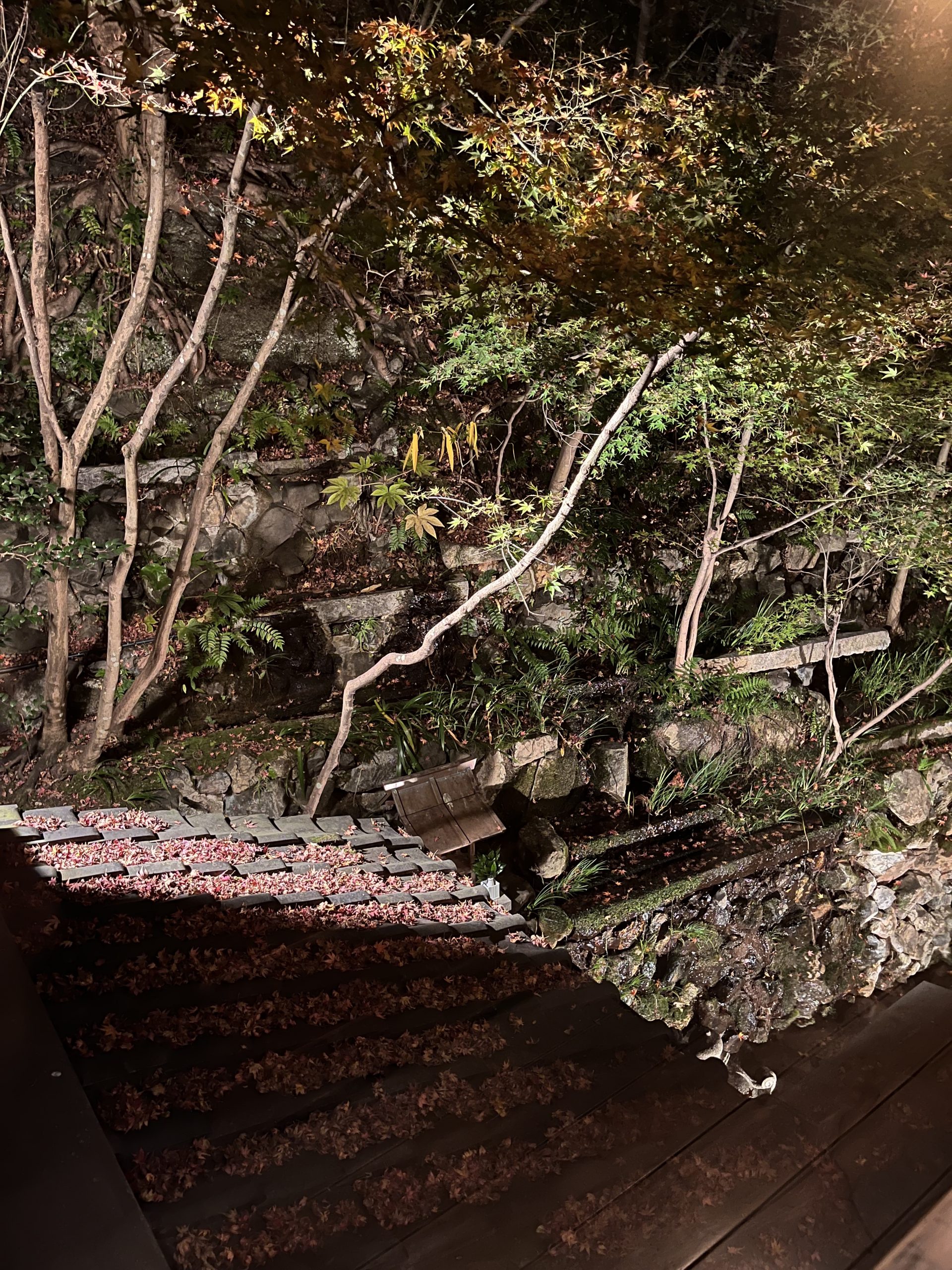
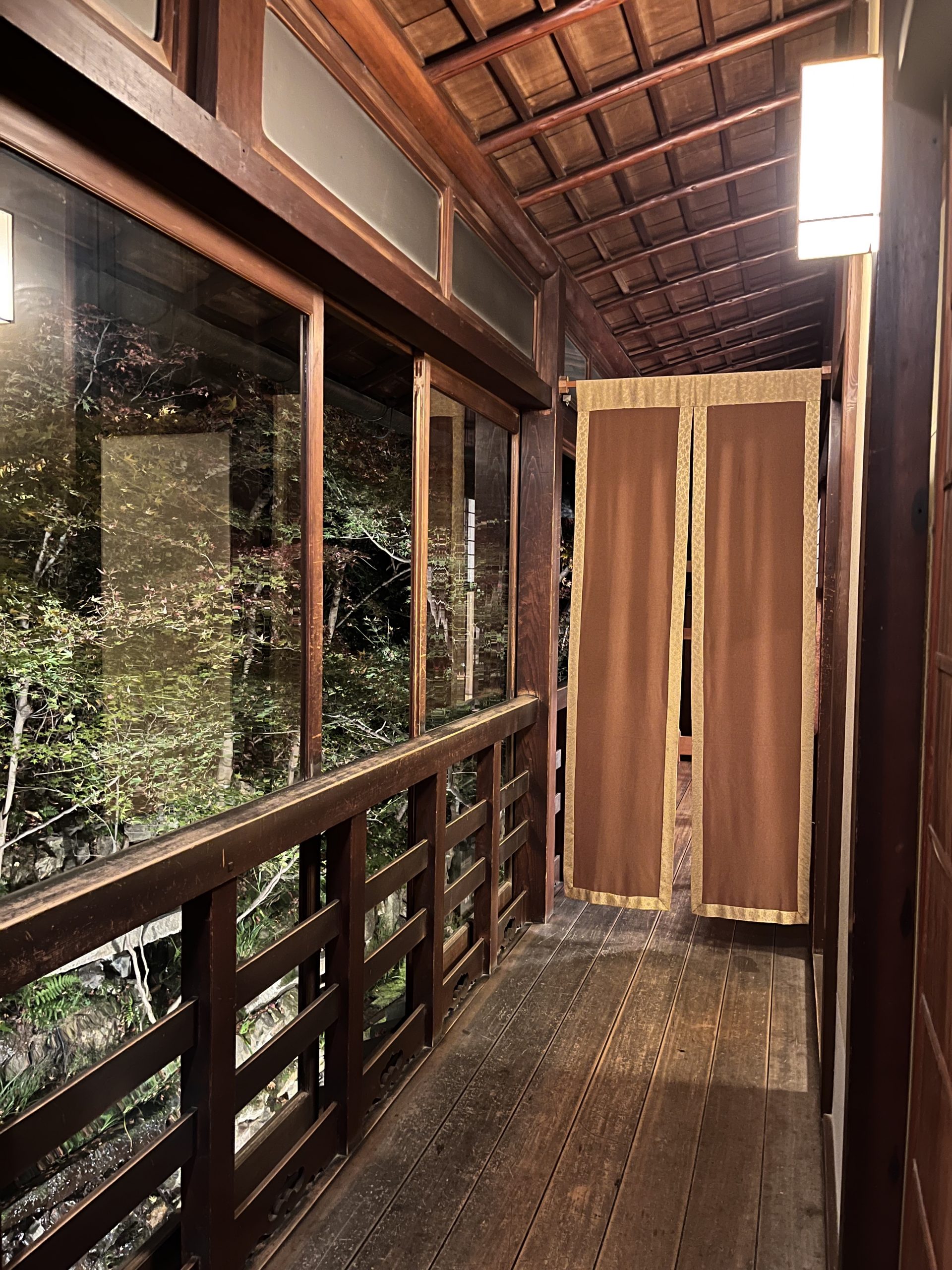
The price at Kikunoi Honten
For a meal at Kikunoi Honten, a three-starred Michelin restaurant situated in one of Kyoto’s premium locations, expect to allocate a significant portion of your dining budget. It’s important to note that if you book through a third-party reservation service, an additional fee of 8000 yen will be applied to the prices listed below:
The Lunch course is priced at 29,000 yen per person.
The Dinner B course, featuring luxurious ingredients, comes in at 47,500 yen per person.
The Dinner C course, offering a selection of second-tier luxurious ingredients, is priced at 60,500 yen per person.
The Kikunoi Special course, featuring the most opulent ingredients, will set you back 74,000 yen per person.
For our dining experience, we chose the Dinner B course. In GBP and USD, this approximately equates to £260 or $325 per person. Needless to say, this experience carries a notable price tag.
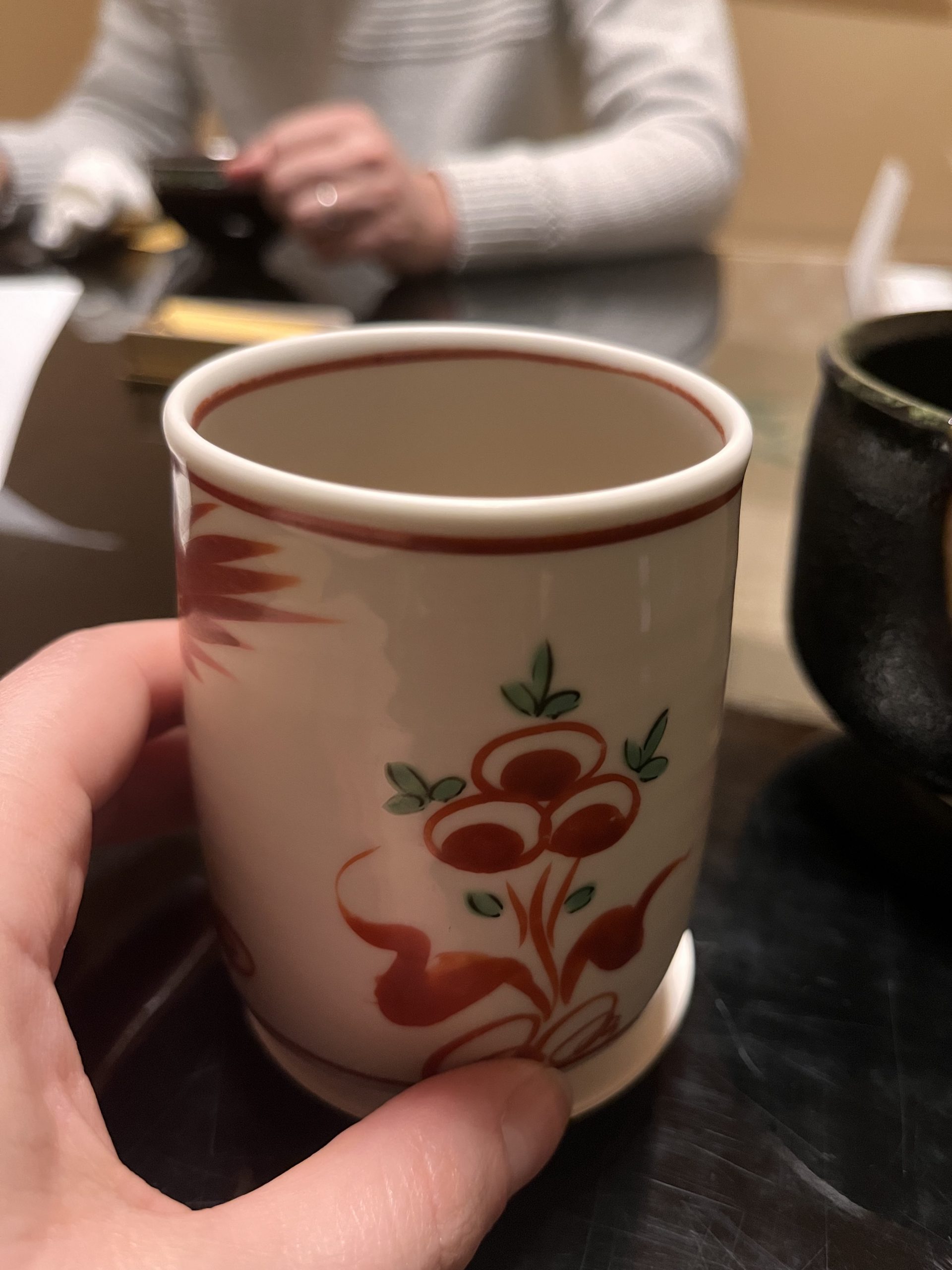
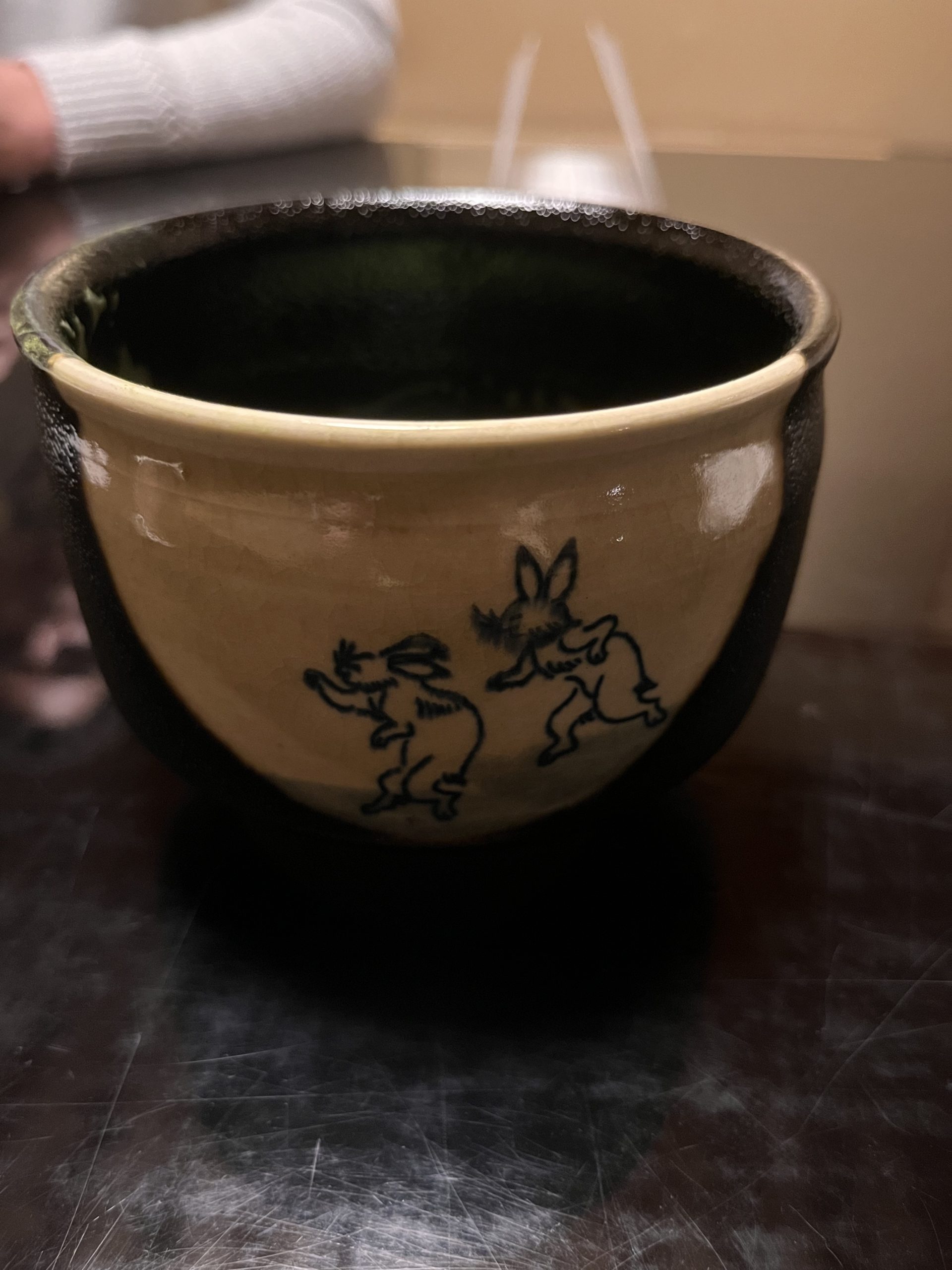
Personal Thoughts
So, is dining at Kikunoi Honten worth the hype and the price? For me, the answer is complicated. I didn’t walk away feeling wowed, especially when considering the cost. I’ve had better meals at other Michelin-starred places, and even some less fancy kaiseki spots have delivered more for less money. So, if you’re asking whether it was worth the price tag, my answer is no.
That said, I don’t regret going. I would have always wondered what I was missing out on, so in that sense, it was an experience worth having. I’m glad I had the opportunity to try it, if only to satisfy my curiosity.
Date of Visit: Our dining experience took place in December 2022. It’s worth noting that Kikunoi Honten features an ever-changing menu, so it’s unlikely that future diners will encounter the same dishes that we did. In researching prior to our visit, I observed a mix of dishes—some closely resembling what we were served and others that looked far more appealing. This suggests that the dining experience can be somewhat hit or miss. However, given the restaurant’s prestigious status, one would reasonably expect a consistent standard of excellence in service, dish quality, and presentation, regardless of the specific items on the menu.
I hope my review and the accompanying photos give you enough insight to make your own call on whether it’s worth a visit.

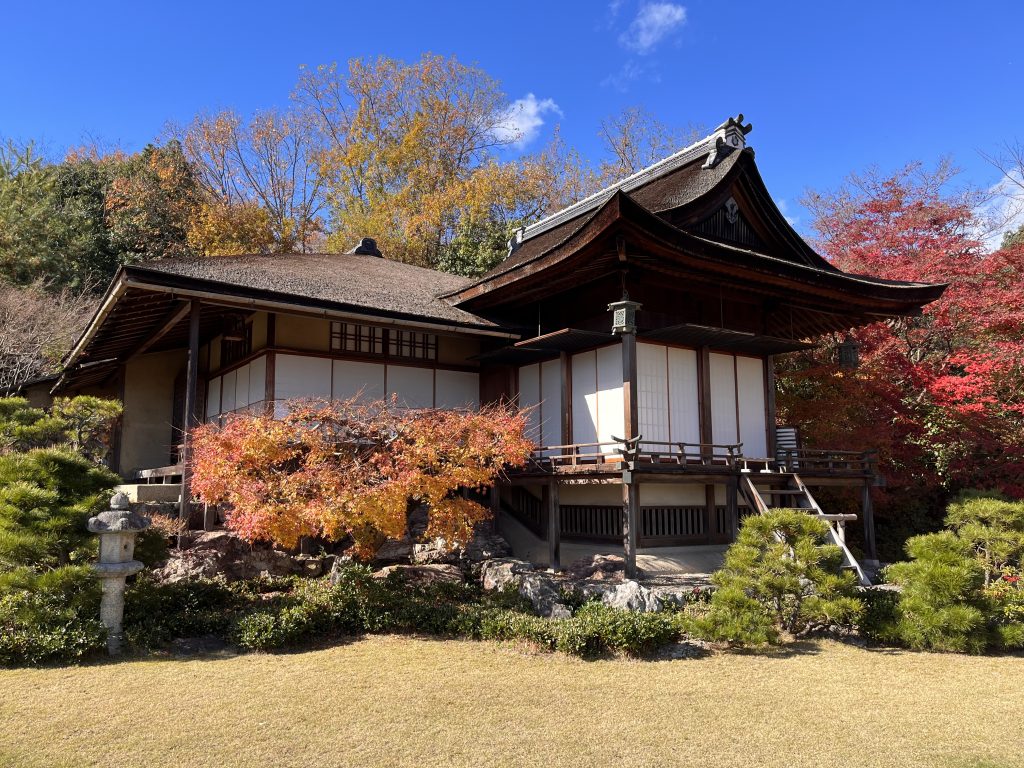
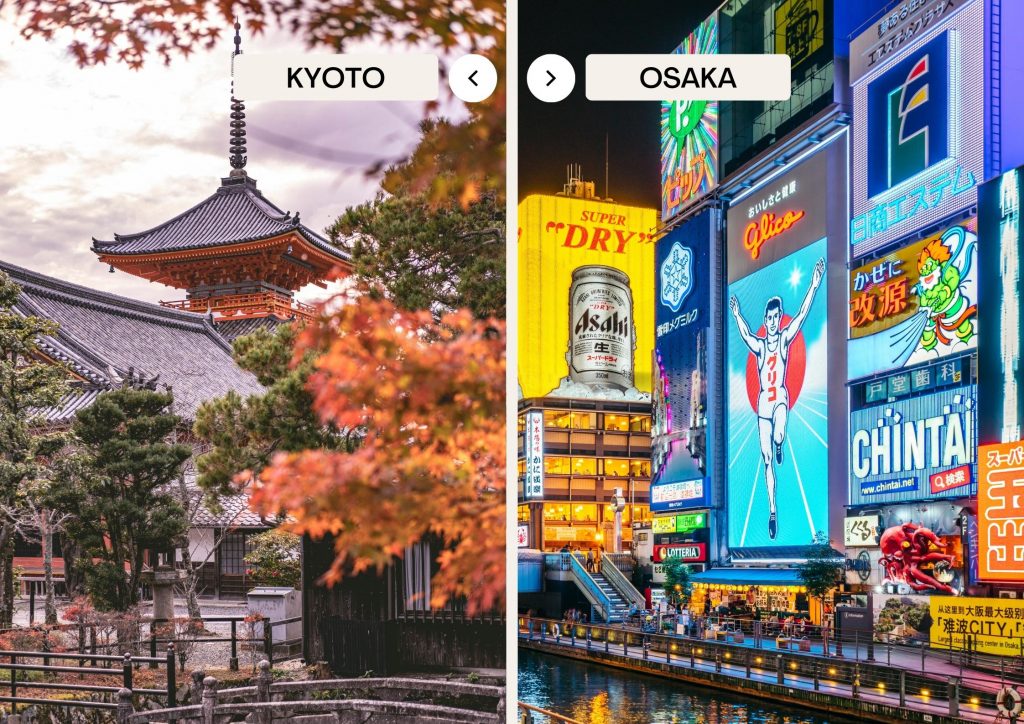
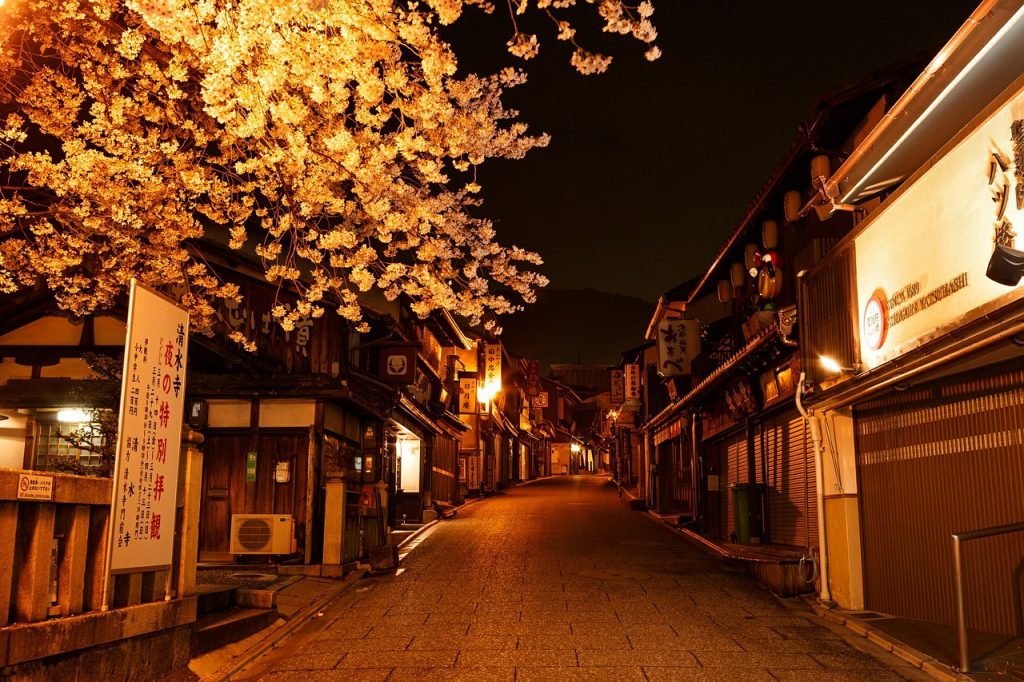
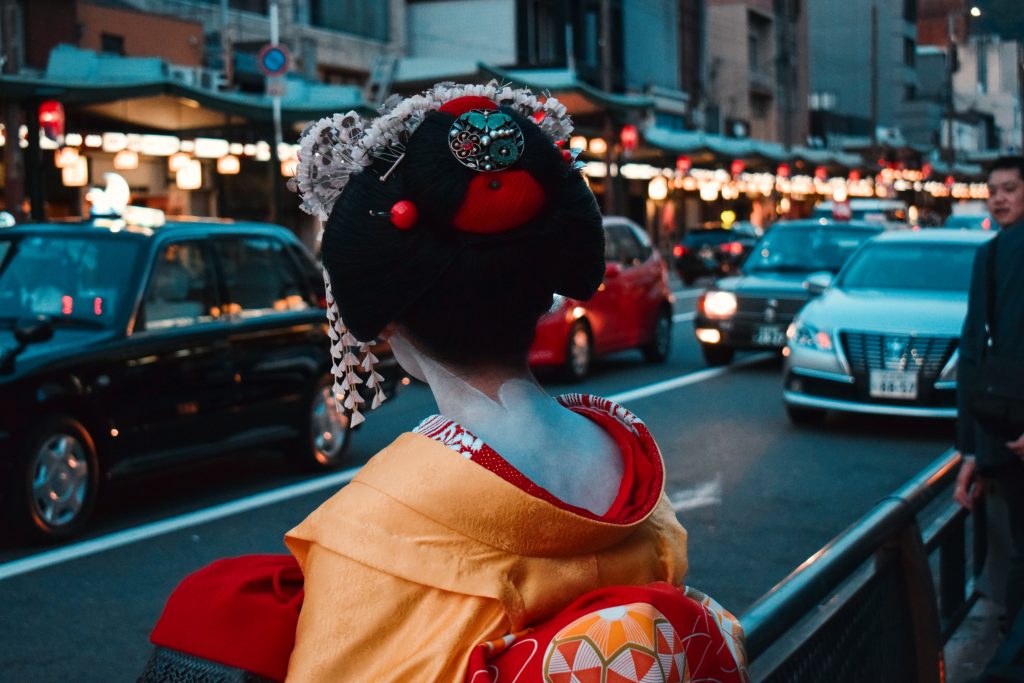
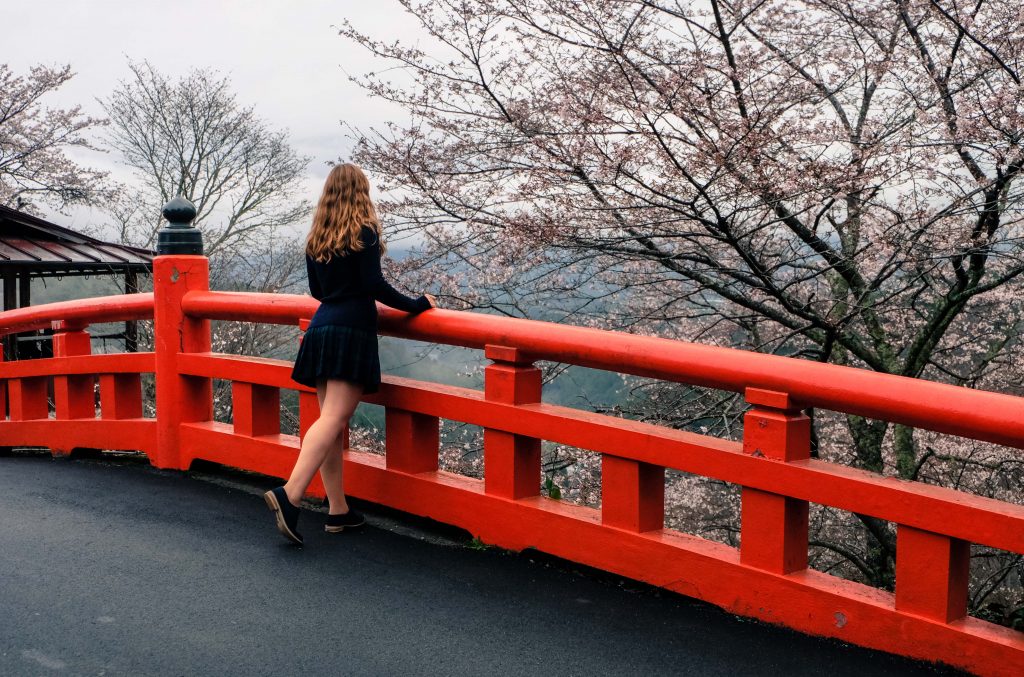
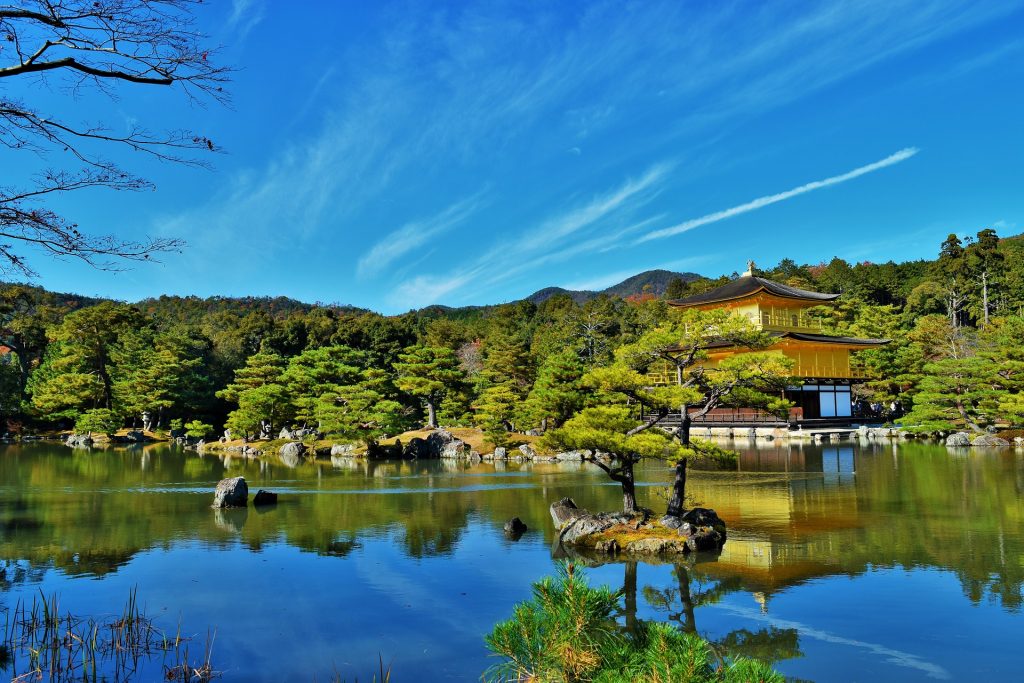


Leave a Reply